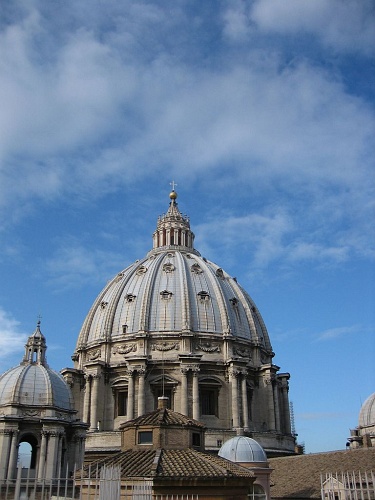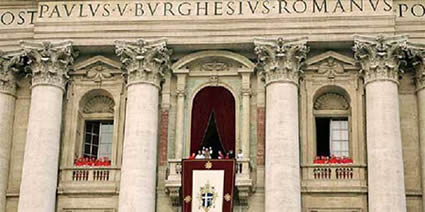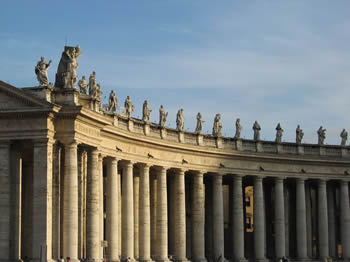

 |
|||||||||||
 |
|||||||||||
Not only was St. Peters completed in 1626 but it holds works from such artists as Michelangelo, Carlo Maderno, Bernini, Antonio Averulino, Vico Consorti, great artist from the Italian Renaissance and from the 20th century. These artists created St. Peter's with innovations that exceeded their time period.
|
|
 |
St. Peters is famous for its dome designed by Michelangelo. The dome is made of brick and is 42.3 meters in interior diameter, rising 120 meters. This dome astonishes every visitor by the capability of the architects to create a cupola with such a vast scale during the Italian Renaissance. It is also magnificent because it is not a hemisphere but a parabola. The bold ribbing that comes from the paired Corinthian columns magnifies the vertical thrust of the parabola; their columns are part of the drum, which stand away to absorb the outward thrust of the dome’s weight. Michelangelo’s and the other architects that worked on this dome had extraordinary minds to design a dome that demonstrates architectural strengths, and design beauty of the Italian Renaissance. |
The new Pope is announced on the central balcony or Loggia of the Blessing with “Havemus Papum” and his Urbi et Orbi blessing. Under this balcony is a relief of Christ giving the keys to St. Peter. Christianity during the early Italian Renaissance was doubted, and questioned. The papacy emerged supreme in ecclesiastical matters; but was constantly accused of corruption especially the Pope. So during this time of questionable faith in the church the biggest place of worship was built. Showing innovations of the government and church deciding against the ones who questioned Christianity. |
 |
 |
St. Peter’s Square is outlined by Bernini’s monumental colonnade. The colonnade’s symbolic open arms welcome the world into the Catholic Church. Between the obelisk and each fountain is a circular stone that marks the points of an ellipse. By standing on one of these points the two row columns of the colonnade line up perfectly and appear to be a single row. The innovations of Bernini include this colonnade; what make this monument so innovative are the points of the stone that match an ellipse, the columns will turn to one row. Tying astrology, architecture and religion into one, something few believed possible in the Italian renaissance. |